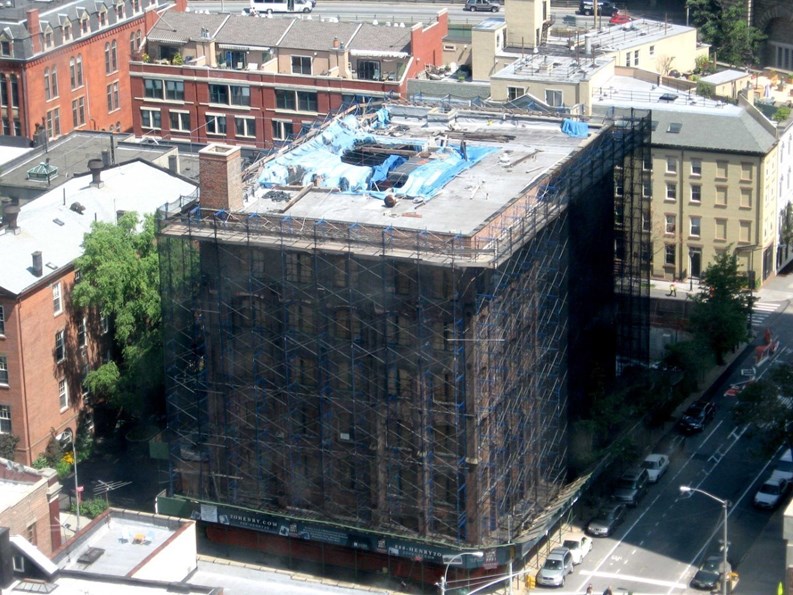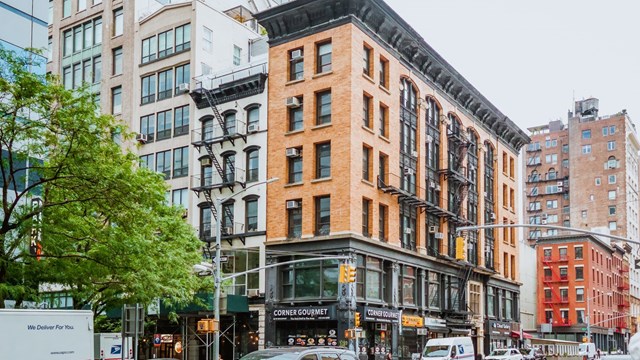A short distance away from this writer’s “regular,” non-Cooperator job in Downtown Brooklyn is a large, empty edifice, a former industrial building. A year or so ago, the conversion of this building to condos was a big deal—a sales office was opened, colorful signs were put up, and construction workers were seen on the site every day.
Today, for reasons not entirely clear, the site is quiet. The foundation initially dug for an annex is covered over with wooden planks, presumably for safety reasons. The sales office is closed, and the only work that has been done in recent months was an emergency roof repair.
A building project stopping in the middle of construction may be unusual — but it is not unique. Some projects are proposed and heavily promoted, but never even get off the ground, leaving just an empty lot. An article by David Amsden in the July 12th, 2009 edition of New York magazine titled The Billyburg Bust says that the trendy Brooklyn neighborhood “[now has] so many vacant lots and half-completed buildings—(the current number in all of Brooklyn is 237)—that large swaths of the neighborhood have come to resemble a city after an air raid.”
The problem has become so prevalent that the DOB began tracking stalled construction projects over the summer and set up a task force to deal with the issue. According to The New York Building Congress, which has analyzed the DOB information, currently there are 515 stalled construction projects in the five boroughs.
The Northern Brooklyn neighborhoods of Williamsburg, East Williamsburg, Greenpoint and North Side-South Side, which have been the focus of intense residential development in recent years, are home to 30 percent of the stalled Brooklyn projects.
In October, a Brooklyn-based advocacy group—Families United for Racial and Economic Equality (FUREE)—identified 600 stalled or troubled residential developments in the city. Some neighborhoods have been particularly hard hit. For example, a recent survey taken by Assemblyman Hakeem Jeffries (D-Flatbush/Fort Greene/Park Slope/Bed-Stuy), revealed that 65 condo buildings in Central Brooklyn alone are troubled.
No matter which numbers you use, there’s clearly a problem. Existing complaints concerning “over-development” were circulating long before the burst of the development bubble. Leading to an overall general bust in the economy, now neighborhoods—like Downtown Manhattan and Brooklyn, for example— are impacted by the massive Wall Street layoffs. And since many luxury condo buyers have traditionally come from the financial services sector, the situation appears to be an entangled web of problems, less conceptual and more visual—with empty lots and bare steal and wrought iron frames standing as a sign of these stagnant times.
What’s the Reason?
Quite a few fingers are being pointed, says Dan Goldstein, a well-known community activist in Prospect Heights. Speaking as a private individual, he says, “There was a real estate development bubble and rampant speculation, now that the economy has crashed, the speculators and buyers are not speculating and buying.”
Dr. Kenneth Patton, divisional dean of the NYU Schack Institute of Real Estate says, “There are several reasons why there are [troubled condos]. Lender distress is pressing lenders to in turn press developers to pay back loans. Borrowers are frequently spread too thin due to gluttony for projects, and the price of units has seen a 20 percent downturn. There's also the inexcusable slowness of the city to approve grants, the Attorney General to approve offering plans, and the Buildings Department to issue [temporary Certificate of Occupancy’s] TCOs. These factors have pushed projects back into bad times.”
And Lupe Todd, a spokeswoman for Assemblyman Jeffries, partially blames the city administration. “Under this current administration, we have a mayor who enjoys building. What we’ve seen in Central Brooklyn is that when the market was at its greatest height, there was an exuberance to overbuild. As the economy continued to rise, some didn’t check balances [of development vs. the demand for condos], and when the market went bust, many condos are unable to fill their space because there has been an oversaturation in certain areas.”
So, what happens when a developer can’t complete a building that’s already under construction? One very obvious answer is that it puts many construction workers out of work—further hurting the local economy—much like the Be@Schermerhorn development, located at 189 Schermerhorn Street in Downtown Brooklyn—a 246-unit condominium which was 92-percent complete before construction drew to a halt.
“We have painters, plumbers, electricians and contractors from multiple trades working together on site and are thrilled by the progress we are seeing,” said Mario Procida, president of SDS Procida, in a press release announcing that construction has recommenced. “Everyone involved is excited to be back at work and looking forward to finishing the quality product we started two years ago.”
Marolyn Davenport, senior vice president of the Real Estate Board of New York (REBNY), believes that stopping construction on a building in the middle of a job is fairly rare. “If it’s partially built, they’re going to continue building.” If they haven’t started or have just built the foundation and nothing else, she said, that’s when you may have problems, leaving an unsightly open lot.
Todd added that in many properties that are vacant or under construction, “many developers are trying to wait it out [until market conditions approve]. Meanwhile, they are bleeding money.”
In many cases like this, or in cases of buildings that are completed but still vacant, “some have given the project back to the bank,” continues Todd. Several examples of such buildings in her area, she says, are the 63-unit Isabella at 545 Washington Avenue, which has been on the market for a year but is still vacant; the 30-unit Collection at 525 Clinton Avenue, also vacant; and the dramatic-looking, partially-occupied Forte at 230 Ashland Place, where the Clarett Group and Goldman Sachs ceded control of the development to the lender, Eurohypo Bank. Lower Manhattan has The Exchange at 25 Broad Street, 20 Pine, The Collection, and One Rector Park; Midtown, Sheffield57, as examples of troubled projects.
Here’s another problem—say, a new building is only occupied by a few people and then sales either grind to a halt or the developer finds it difficult to sell more condos. How does that impact those owners and their apartments?
“That is a big problem for those owners and the building sponsor. It could drive up common charges, drive down unit prices,” says Goldstein, who is best known for his opposition to the Atlantic Yards project.
Offering Lower Prices – Cars & Auctions
Developers stuck with buildings that have already been finished, but are only partially occupied and have trouble attracting buyers have several options. One is to lower prices.
For example, the Oro Condominiums on Gold Street in Downtown Brooklyn lowered prices for units in October, although they framed their announcement by saying there was an upswing of interest in buying and that the price reductions were a way of accelerating sales even more. Price reductions on some units were as much as 25 percent.
Also in Brooklyn, the iconic former Williamsburgh Bank Building, now known as One Hanson Place, reduced prices in August 2009 on some of its available condo units, one of them as much as 23 percent.
In a few cases, developers are going so far as to offer expensive incentives to buyers—including cars, in at least two cases. At the Windows on 123 condo in Harlem, the developer offered a new SmartCar to anyone who purchased one of the building’s parking spaces. At the One Brooklyn Bridge Park condo conversion, any buyer of a unit worth $2 million or more also got a new Audi.
Other developers are shifting gears from condo to rental formats in some buildings, and some the city has been using for homeless shelters or affordable housing.
Patton says “rental of for-sale units can be a problem but since they remain under sponsor control, there should be some discipline over tenant quality. After the sponsor loses control of the association, management and improvements can difficult.”
Another recent tactic is hitting the auction block. Solaria in Riverdale, a luxury condo that features a rooftop observatory, went that route in late November. Fifty-four of the 64 units were unsold and placed for auction through national liquidator Real Estate Disposition LLC (REDC). More than 550 people attended the auction to bid on residences that originally listed from $660,000 to $4.35 million. At the auction, REDC sold 21 of the 54 available apartments at prices more than half of the original listing price, generating over $17 million in sales.
And in Brooklyn’s first auction, all 16 units of The Locale were put on the block in November by real estate auction firm Sheldon Good & Company. Units were originally asking from $445,000 to $599,000, and starting bids were announced at $150,000. The auction attracted 260 people and had four lucky bidders.
Legislative Options
Getting back to the issue of non-completed building, when there’s a half-finished building, or a building where the foundation has been dug and that’s it, all sorts of problems can ensue: rodents, mosquitoes, safety hazards, exposed machinery, broken fencing—even squatters or criminal activity.
To this end, the City Council recently adopted legislation backed by Speaker Christine Quinn that requires builders who participate in a new program to notify the DOB when work on a project has stalled, and to submit a detailed safety monitoring and inspection plan. In return, the participating builders would be allowed to renew building permits at stalled sites for up to four years, allowing them to expedite construction when the economy becomes better. Currently, construction permits expire if work has not begun—or is suspended—within 12 months.
This new legislation is largely considered a “win-win:” a win for neighbors who don’t want unsafe, unsecured sites in their areas, and a win for builders who can quickly resume the building process when the time is right. Davenport adds that her organization had a hand in formulating this bill and worked closely with legislators.
In the case of luxury condo developments that are finished but are either vacant or substantially unoccupied, and are in otherwise working-class or middle-class neighborhoods, Assemblyman Jeffries has proposed “Project Reclaim,” which could convert some of these dormant luxury condo units into affordable housing. The developers would receive incentives, says Todd, “but not a bailout.”
“He has legislation in Albany, co-sponsored by State Sen. Velmanette Montgomery [also from Brooklyn] that would allow the New York State Mortgage Authority to 'incentivize' and bond the developer so they could turn the project into affordable condo or rental properties,” says Todd. “Right now they can’t do that in the state of New York.”
As the recession grinds on, the ultimate impact on the area's residential development landscape will become clearer. In the meantime, both developers and government agencies are looking for ways to partner with each other to address the problem of troubled building projects.
Raanan Geberer is a freelance writer and newspaper editor living in Manhattan.







Leave a Comment